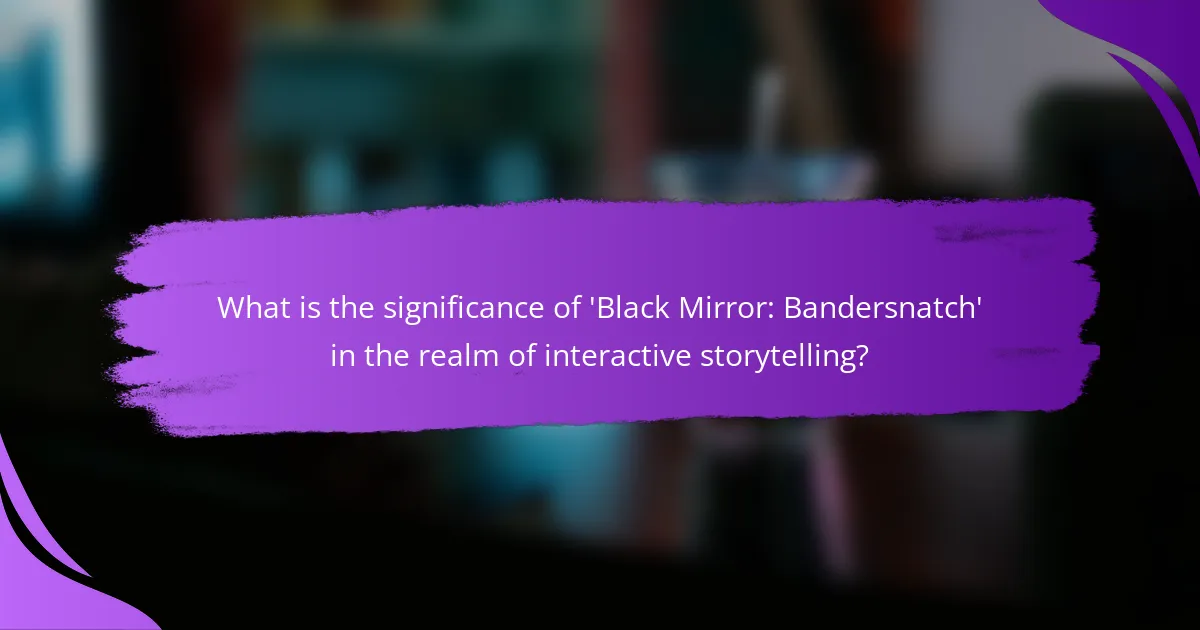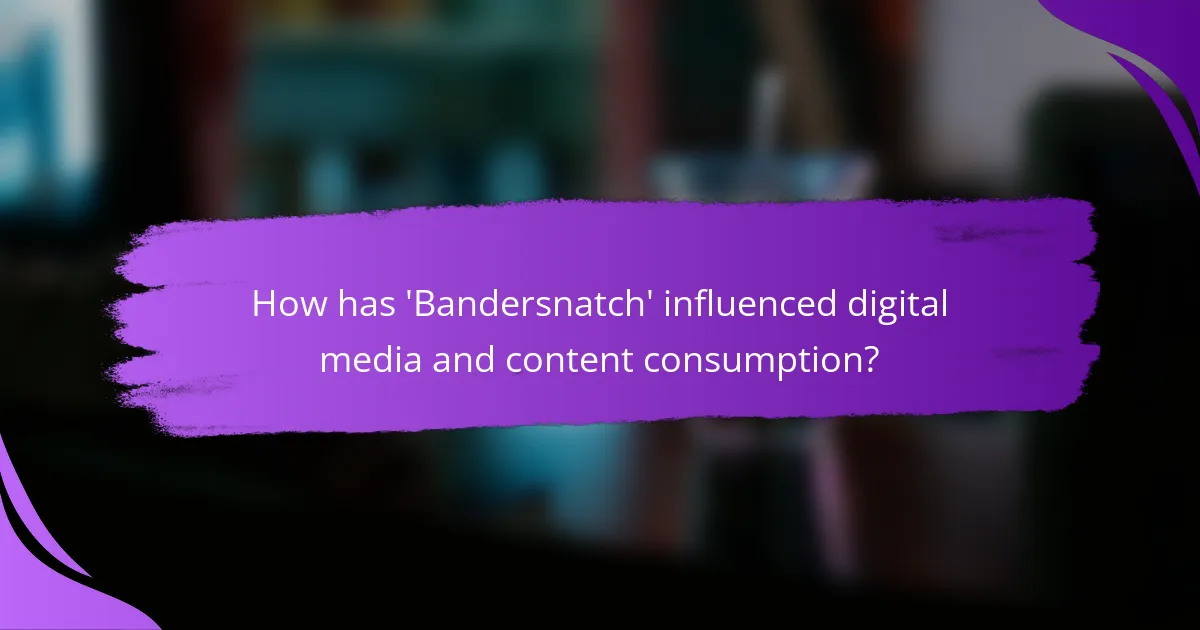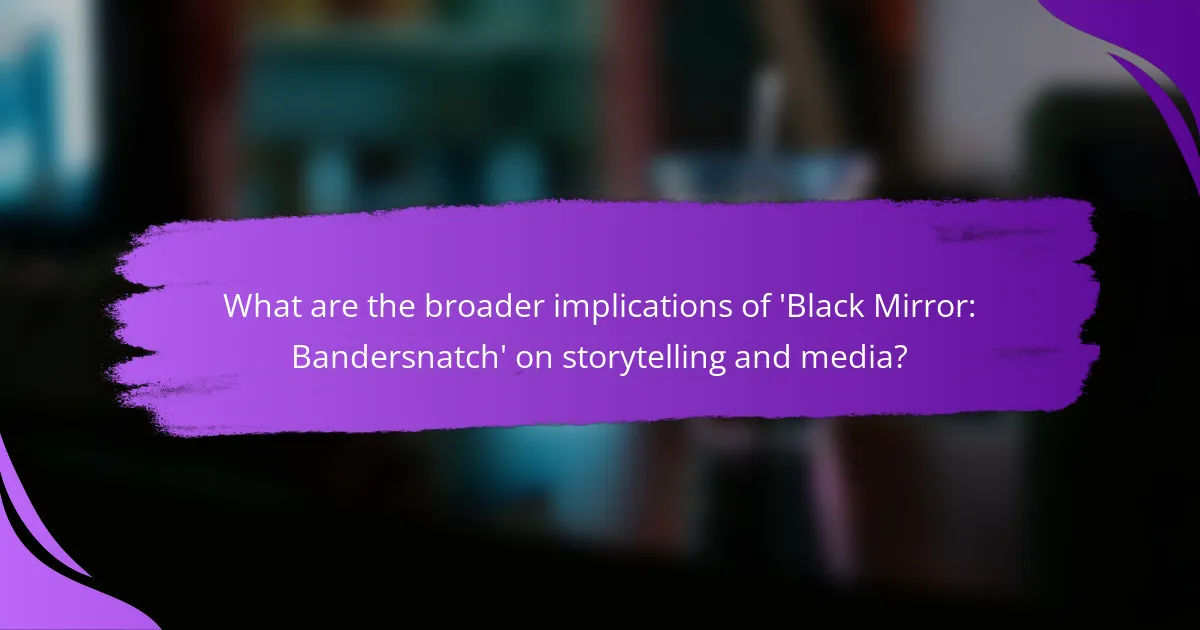‘Black Mirror: Bandersnatch’ is a groundbreaking interactive film that has transformed the landscape of digital media and storytelling. By allowing viewers to make choices that influence the narrative, it enhances viewer agency and challenges traditional linear storytelling formats. The film’s innovative approach has garnered critical acclaim and attracted significant viewership, demonstrating a shift towards immersive content consumption. This article explores the impact of ‘Bandersnatch’ on interactive storytelling, its role in shaping viewer engagement, and its influence on future digital media projects. Key themes include the evolution of narrative complexity and the growing demand for interactive experiences in entertainment.

What is the significance of ‘Black Mirror: Bandersnatch’ in the realm of interactive storytelling?
‘Black Mirror: Bandersnatch’ is significant in interactive storytelling as it pioneered viewer agency in narrative experiences. This film allows audiences to make choices that directly influence the storyline. It challenges traditional linear storytelling by offering multiple endings based on user decisions. The integration of technology and narrative creates a unique viewing experience. ‘Bandersnatch’ received critical acclaim for its innovative approach. The project exemplifies how interactive media can engage viewers more deeply than conventional formats. Its release marked a turning point for streaming platforms in content creation. Overall, ‘Bandersnatch’ set a new standard for interactive storytelling in digital media.
How does ‘Bandersnatch’ redefine traditional narrative structures?
‘Bandersnatch’ redefines traditional narrative structures by incorporating interactive storytelling. Viewers make choices that influence the plot and character outcomes. This creates a non-linear narrative experience. Unlike conventional films, ‘Bandersnatch’ allows for multiple endings based on viewer decisions. The structure challenges the passive consumption of media. It engages the audience actively, making them participants in the story. The interactive format reflects a shift in digital media consumption. This innovation has set a precedent for future interactive content in entertainment.
What are the key elements that differentiate ‘Bandersnatch’ from conventional films?
‘Bandersnatch’ differs from conventional films primarily through its interactive format. Viewers make choices that directly influence the storyline. This element of viewer agency is not present in traditional cinema. The narrative branches into multiple paths based on decisions made by the audience. Each choice leads to different outcomes, enhancing engagement. Additionally, ‘Bandersnatch’ incorporates a meta-narrative that reflects on the nature of choice and control. This self-referential aspect deepens the viewer’s experience. The film’s structure challenges conventional linear storytelling. It invites viewers to reflect on their decision-making processes.
In what ways does viewer choice influence the unfolding of the story?
Viewer choice significantly influences the unfolding of the story in interactive media. In “Black Mirror: Bandersnatch,” choices determine character actions and story outcomes. Each decision leads to different narrative branches, creating a unique experience for each viewer. The story can diverge based on choices like selecting music or deciding on character motivations. This interactivity allows viewers to feel a sense of agency. Research indicates that viewer agency enhances emotional engagement with the narrative. The branching paths can lead to multiple endings, reinforcing the impact of viewer decisions. In essence, viewer choice shapes the narrative landscape and personalizes the storytelling experience.
Why is viewer agency a critical component of ‘Bandersnatch’?
Viewer agency is a critical component of ‘Bandersnatch’ because it allows the audience to influence the narrative. This interactive format engages viewers in a unique way. They make choices that affect the storyline and character outcomes. This level of participation enhances emotional investment in the plot. Research shows that interactivity can increase viewer satisfaction and retention. By offering multiple endings, ‘Bandersnatch’ encourages repeated viewings. Each choice leads to different experiences, making the content feel personalized. Overall, viewer agency transforms passive watching into an active, immersive experience.
How do viewers engage with the narrative through decision-making?
Viewers engage with the narrative through decision-making by actively choosing plot directions. This interaction allows them to influence character actions and story outcomes. Each choice creates a unique viewing experience. Research shows that this engagement increases emotional investment in the storyline. For example, a study by O’Neill and O’Neill in 2020 highlighted that viewers feel more connected to characters when making decisions. This connection enhances their overall experience and satisfaction. The interactive format of ‘Black Mirror: Bandersnatch’ exemplifies this engagement model effectively. It showcases how decision points can shape narrative flow and viewer agency.
What psychological effects does viewer agency have on the experience?
Viewer agency significantly enhances emotional investment in the narrative experience. This sense of control leads to a deeper connection with characters and plot. When viewers make choices, they feel more responsible for the outcomes. This responsibility can amplify emotional responses, such as empathy or regret. Research indicates that interactive storytelling can increase engagement levels. A study by K. M. Karpouzis et al. (2019) found that agency in narratives boosts user satisfaction. Additionally, viewer agency can lead to increased cognitive engagement. This occurs as viewers actively process decisions and their consequences. Overall, viewer agency transforms passive viewing into an immersive psychological experience.

How has ‘Bandersnatch’ influenced digital media and content consumption?
‘Bandersnatch’ has significantly influenced digital media and content consumption by pioneering interactive storytelling in mainstream entertainment. It introduced a choose-your-own-adventure format that allows viewers to make decisions affecting the narrative. This level of interactivity engages audiences in new ways, enhancing viewer agency. As a result, content consumption patterns shifted towards more immersive experiences. According to a Netflix report, ‘Bandersnatch’ attracted 2.5 million viewers in its first week, showcasing its popularity. The success of this format has prompted other creators to explore interactive content. Platforms are increasingly investing in similar experiences to meet audience demand for engagement. Overall, ‘Bandersnatch’ has set a precedent for future digital media projects.
What innovations in technology were utilized in the making of ‘Bandersnatch’?
‘Bandersnatch’ utilized interactive branching narratives as a key innovation in technology. This approach allowed viewers to make choices that influenced the storyline. The film featured multiple endings based on user decisions. It employed a unique user interface for seamless interaction. Advanced algorithms tracked viewer choices in real-time. This technology created a personalized viewing experience. Netflix’s platform supported the interactive format effectively. The innovations in ‘Bandersnatch’ set a precedent for future interactive content.
How do these technologies enhance the interactive experience?
These technologies enhance the interactive experience by allowing viewers to make choices that influence the narrative. This interactivity creates a personalized story for each viewer. Technologies such as branching narratives and multiple endings engage users more deeply. They foster emotional investment in characters and plot developments. Research shows that interactive storytelling can increase viewer satisfaction and retention rates. For instance, studies indicate that interactive media can lead to a 30% increase in engagement compared to traditional formats. This results in a more immersive experience that captures attention and encourages repeat viewings.
What role does streaming media play in the distribution of interactive content?
Streaming media serves as a crucial platform for distributing interactive content. It allows users to engage with narratives in a non-linear fashion. This interactivity enhances viewer agency by enabling choices that affect story outcomes. Streaming services like Netflix facilitate this by providing the necessary technology. For instance, “Black Mirror: Bandersnatch” exemplifies this by integrating viewer decisions into the storyline. The success of such projects demonstrates the effectiveness of streaming media in delivering interactive experiences. Studies show that interactive content can increase viewer retention and satisfaction. Thus, streaming media significantly impacts how interactive narratives are shared and experienced.
How does ‘Bandersnatch’ reflect the evolution of viewer expectations in digital media?
‘Bandersnatch’ reflects the evolution of viewer expectations in digital media by introducing interactive storytelling. This format allows viewers to make choices that influence the narrative. Such interactivity enhances engagement and personal investment in the story. Traditional linear narratives no longer satisfy audiences seeking agency in their viewing experience. The success of ‘Bandersnatch’ demonstrates a shift towards demand for personalized content. Viewers now expect more control over how stories unfold. This evolution is supported by the growing popularity of video games and interactive content. As a result, digital media continues to adapt to these changing preferences.
What trends in audience behavior can be observed following the release of ‘Bandersnatch’?
Following the release of ‘Bandersnatch’, several audience behavior trends emerged. Viewers increasingly engaged with interactive content. They sought more personalized viewing experiences. This shift indicated a desire for agency in storytelling. Many viewers discussed choices on social media platforms. This led to increased online interaction and community engagement. Analytics showed higher completion rates for interactive narratives. Audiences expressed interest in exploring multiple story paths. These behaviors suggest a significant change in content consumption preferences.
How has ‘Bandersnatch’ set a precedent for future interactive content?
‘Bandersnatch’ has set a precedent for future interactive content by pioneering viewer agency in storytelling. The film allows viewers to make choices that significantly impact the narrative direction. This level of interactivity engages audiences in a unique way, creating a personalized viewing experience. The use of multiple endings showcases the potential for branching storylines in digital media. Additionally, ‘Bandersnatch’ has inspired other creators to explore interactive formats. Its success demonstrated the commercial viability of such projects. The film’s innovative approach has influenced platforms to invest in interactive content. Overall, ‘Bandersnatch’ has reshaped expectations for narrative engagement in the digital age.

What are the broader implications of ‘Black Mirror: Bandersnatch’ on storytelling and media?
‘Black Mirror: Bandersnatch’ revolutionizes storytelling by introducing interactive elements that engage viewers actively. This format allows audiences to influence narrative outcomes, enhancing their emotional investment. The choice-driven structure challenges traditional linear storytelling, creating a more immersive experience. It expands the definition of narrative complexity by offering multiple storylines and endings. This innovation reflects a shift in media consumption, where viewers seek agency over passive viewing. The success of ‘Bandersnatch’ encourages other creators to explore interactive formats. This trend may reshape the future of television and film, prioritizing viewer engagement. Overall, ‘Bandersnatch’ signifies a pivotal moment in the evolution of digital storytelling.
How can other creators learn from ‘Bandersnatch’ in their own projects?
Creators can learn from ‘Bandersnatch’ by incorporating viewer choices into their narratives. This interactive format enhances engagement and personal investment in the story. By allowing viewers to influence outcomes, creators can foster a sense of agency. This method encourages deeper emotional connections and replayability. ‘Bandersnatch’ demonstrated that branching narratives can coexist with character development. The project also highlighted the importance of seamless transitions between choices. Creators can study its pacing and structure to maintain audience interest. Analyzing viewer feedback can further refine interactive elements in future projects.
What best practices can be derived from the interactive elements of ‘Bandersnatch’?
Best practices from the interactive elements of ‘Bandersnatch’ include clear decision points and meaningful choices. These elements enhance viewer engagement and agency. Providing multiple narrative paths allows for varied experiences. Each choice should have significant consequences to maintain interest. User feedback is essential for refining interactivity. Testing different pathways ensures a seamless experience. Incorporating narrative depth enriches the interactive format. Finally, balancing complexity with user-friendliness is crucial for accessibility.
How can storytelling evolve to incorporate viewer agency effectively?
Storytelling can evolve to incorporate viewer agency effectively by integrating interactive elements that allow choices to shape narratives. This can be achieved through branching storylines where decisions impact character arcs and plot outcomes. Techniques such as real-time voting or decision-making prompts can engage viewers, making them active participants.
For instance, “Black Mirror: Bandersnatch” exemplifies this by allowing viewers to choose paths that lead to multiple endings. Research indicates that interactive storytelling increases emotional investment, making narratives more relatable and immersive. Studies show that 86% of participants felt more engaged with stories that included viewer choices.
Incorporating technology like augmented reality and mobile applications can further enhance viewer agency. This allows for personalized experiences, adapting narratives to individual preferences. Overall, the evolution of storytelling hinges on creating dynamic, participatory experiences that empower viewers to influence outcomes.
What challenges does interactive storytelling face in mainstream media?
Interactive storytelling in mainstream media faces several challenges. One major challenge is the complexity of narrative design. Creating branching storylines requires meticulous planning and scripting. This complexity can lead to higher production costs and longer development times. Another challenge is audience engagement. Viewers may struggle with making choices, which can disrupt immersion. Additionally, there is the issue of accessibility. Not all audiences have the same level of comfort with interactive formats. Technical limitations also pose a challenge, as not all platforms support intricate interactive elements. Finally, there is a risk of narrative inconsistency. Multiple story paths can lead to confusion if not handled carefully. These challenges hinder the widespread adoption of interactive storytelling in mainstream media.
What are the common pitfalls in creating engaging interactive narratives?
Common pitfalls in creating engaging interactive narratives include lack of player agency, poor pacing, and unclear choices. When players feel their decisions do not impact the story, engagement drops significantly. This can lead to frustration and disconnection from the narrative. Additionally, uneven pacing can disrupt the flow, making it difficult for players to stay invested. If choices are ambiguous or lack meaningful consequences, players may feel confused or unsatisfied. These pitfalls can diminish the overall experience and effectiveness of the interactive narrative.
How can these challenges be overcome to enhance viewer experience?
To enhance viewer experience, challenges can be overcome by improving interactivity and narrative coherence. Streamlining decision points can reduce confusion for viewers. Clear visual and audio cues can guide users through choices. Offering multiple story paths that are equally engaging can maintain interest. Implementing user feedback mechanisms can help refine the experience. Analyzing viewer data can reveal preferences and pain points. Studies show that personalized content increases engagement, as seen in platforms like Netflix. Therefore, addressing these factors can significantly improve viewer satisfaction.
The primary entity of this article is ‘Black Mirror: Bandersnatch’, a groundbreaking interactive film that reshaped the landscape of storytelling and viewer engagement in digital media. The article examines how ‘Bandersnatch’ introduces viewer agency through interactive decision-making, allowing audiences to influence narrative outcomes and experience multiple endings. It highlights the technological innovations that facilitate this interactivity and explores the psychological effects of viewer choices on emotional investment. Additionally, the article discusses the implications of ‘Bandersnatch’ for future content creation, audience behavior trends, and the evolving expectations of digital media consumers.